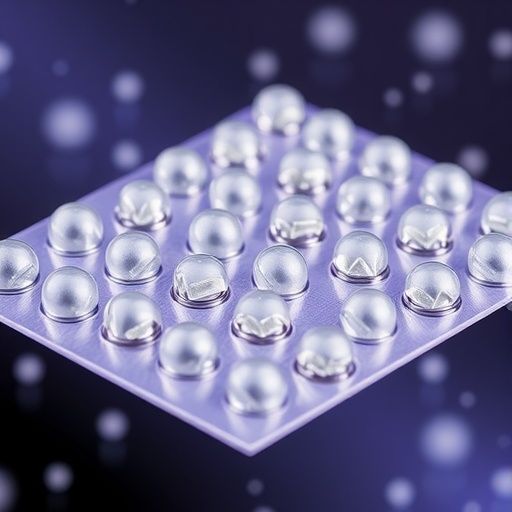A groundbreaking study has unveiled the enhanced photocatalytic properties of silver-doped copper tungsten oxide (CuWO₄) thin films, prepared using the innovative technique of chemical spray pyrolysis. This new research, conducted by a team led by Gomaa, M.M., along with Abdel-Wahed, M.S., and Boshta, M., opens up intriguing possibilities for the application of these materials in environmental remediation, particularly in the degradation of organic pollutants. As the world grapples with increasing pollution levels, the findings present a significant step forward in developing materials that can effectively purify air and water.
The researchers employed chemical spray pyrolysis as a method for synthesizing the CuWO₄ thin films, a process recognized for its versatility and efficiency in producing high-quality semiconductor materials. This technique allows for a uniform deposition of thin films on various substrates, facilitating a wide range of applications in electronics and photocatalysis. What sets this study apart is the incorporation of silver (Ag) into the CuWO₄ matrix, which is expected to enhance the material’s photocatalytic activity through improved light absorption and charge carrier dynamics.
In their experiments, the team demonstrated that the addition of silver significantly influences the structural and optical properties of the CuWO₄ films. The presence of silver nanoparticles not only modifies the band gap of the semiconductor but also enhances its catalytic performance under visible light irradiation. This is particularly crucial for photocatalytic applications, as visible light represents a substantial portion of the solar spectrum that can be harnessed for effective pollutant degradation.
The authors detail how the doping of silver leads to improved electron-hole pair generation, a vital factor in the photocatalytic process. Under illumination, these charge carriers can initiate reactions that break down complex organic molecules into simpler, less harmful constituents. The research provides compelling evidence that optimized silver doping can lead to a substantial increase in the degradation rates of various pollutants, offering a promising avenue for wastewater treatment.
Through a series of experiments, the researchers assessed the photocatalytic efficiency of the Ag-doped CuWO₄ thin films against common industrial pollutants such as dyes and phenolic compounds. The results were remarkable; the silver-doped films demonstrated a faster degradation rate compared to their undoped counterparts. Such findings highlight the potential for these materials to be employed in real-world applications aimed at mitigating environmental contamination.
Moreover, the researchers emphasized the importance of understanding the optimal Ag concentration required for maximizing photocatalytic performance. Too little silver may not yield significant improvements in activity, while excess silver could lead to agglomeration, reducing the overall efficiency. This delicate balance is crucial in the synthesis process, necessitating precise control over the doping level during the chemical spray pyrolysis.
The study also delves into the structural characterization of the produced films using X-ray diffraction (XRD) and scanning electron microscopy (SEM). These advanced characterization techniques allowed the team to confirm the formation of a single-phase CuWO₄ structure with the successful incorporation of silver. The morphology of the thin films, as revealed by SEM, indicates a rough surface that significantly enhances the active sites available for photocatalytic reactions.
In addition to its implications for environmental applications, the research further contributes to the field of material science, specifically in the development of multifunctional photocatalysts. The findings inspire future research into enhancing other semiconductor materials through strategic doping with metals or other types of additives. The potential to extend these principles to a wider array of materials could pave the way for innovative solutions to combat pollution.
As solar energy harvesting becomes increasingly important, the ability to utilize visible light for photocatalytic degradation is paramount. The work of Gomaa and colleagues exemplifies how new material formulations can revolutionize current practices in environmental remediation. By improving the efficiency of photocatalytic processes, these materials can help address some of the most pressing challenges facing society today, including the unchecked proliferation of pollutants and the detrimental effects of industrial waste on ecosystems.
In conclusion, the enhanced photocatalytic performance of Ag-doped CuWO₄ thin films, as presented by this research, represents a significant advancement in the quest for efficient photocatalysts. The innovative use of chemical spray pyrolysis to synthesize these materials, combined with the strategic incorporation of silver, provides a promising framework for future studies aimed at refining photocatalytic systems. As researchers continue to explore and optimize such materials, we can hope for substantial progress in technologies aimed at purifying our planet’s resources.
The authors believe that, with further refinement and research, the findings can transition from the laboratory to practical applications, addressing urgent environmental concerns. With continued interest and investment in photocatalytic technologies, we may be nearing solutions for some of the most critical challenges of our time. The journey towards cleaner air and water through advanced materials science is just beginning.
Subject of Research: Enhanced photocatalytic performance of Ag-doped CuWO₄ thin films.
Article Title: Enhanced photocatalytic performance of Ag-doped CuWO₄ thin films prepared by chemical spray pyrolysis.
Article References:
Gomaa, M.M., Abdel-Wahed, M.S., Boshta, M. et al. Enhanced photocatalytic performance of Ag-doped CuWO₄ thin films prepared by chemical spray pyrolysis.
Environ Sci Pollut Res (2025). https://doi.org/10.1007/s11356-025-37110-y
Image Credits: AI Generated
DOI: https://doi.org/10.1007/s11356-025-37110-y
Keywords: Photocatalysis, Ag-doped CuWO₄, chemical spray pyrolysis, environmental remediation, semiconductor materials.




